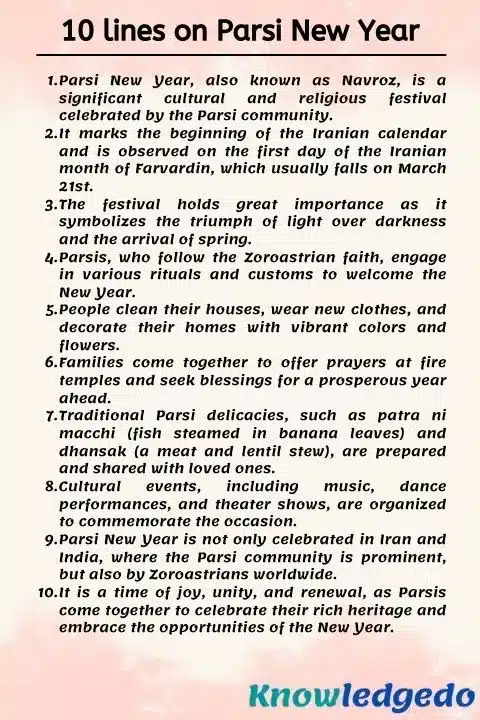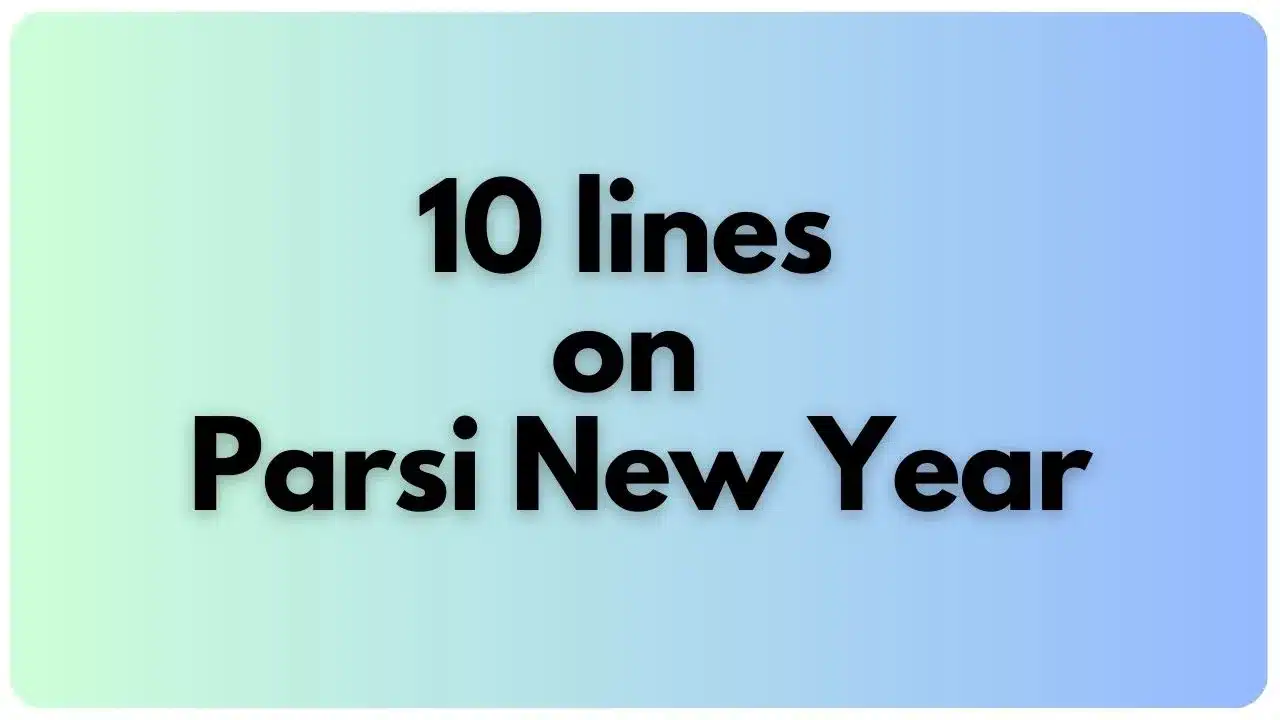Today, we are sharing 10 lines on Parsi New Year in English. This article can help students who are looking for information about 10 lines on Parsi New Year. This Lines is very simple and easy to remember. The level of these Lines is moderate so any student can write on this topic.
This article is generally useful for class 1,class 2,class 3,class 4,class 5,class 6,class 7,class 8,class 9,class 10,class 11,class 12
10 lines on Parsi New Year
1) Parsi New Year, also known as Navroz, is a significant cultural and religious festival celebrated by the Parsi community.
2) It marks the beginning of the Iranian calendar and is observed on the first day of the Iranian month of Farvardin, which usually falls on March 21st.
3) The festival holds great importance as it symbolizes the triumph of light over darkness and the arrival of spring.
4) Parsis, who follow the Zoroastrian faith, engage in various rituals and customs to welcome the New Year.
5) People clean their houses, wear new clothes, and decorate their homes with vibrant colours and flowers.
6) Families come together to offer prayers at fire temples and seek blessings for a prosperous year ahead.
7) Traditional Parsi delicacies, such as patra ni macchi (fish steamed in banana leaves) and dhansak (meat and lentil stew), are prepared and shared with loved ones.
8) Cultural events, including music, dance performances, and theatre shows, are organized to commemorate the occasion.
9) Parsi New Year is not only celebrated in Iran and India, where the Parsi community is prominent, but also by Zoroastrians worldwide.
10) It is a time of joy, unity, and renewal, as Parsis come together to celebrate their rich heritage and embrace the opportunities of the New Year.

5 lines on Parsi New Year
1) Parsi New Year, known as Navroz, is a joyous festival celebrated by the Parsi community.
2) It marks the beginning of the Iranian calendar and symbolizes new beginnings and fresh opportunities.
3) Parsis engage in prayers, clean their homes, and decorate them with vibrant colours and flowers.
4) Traditional Parsi dishes, such as patra ni macchi and dhansak, are prepared and shared among family and friends.
5) Parsi New Year is a time for reflection, togetherness, and embracing the spirit of renewal.
FAQ
Answer: Parsi New Year, also known as Navroz, is typically celebrated on the first day of the Iranian month of Farvardin, which usually falls on March 21st. However, it is important to note that the exact date may vary slightly depending on the lunar calendar.
Answer: Parsi New Year holds cultural and religious significance for the Parsi community. It marks the beginning of the Iranian calendar and symbolizes new beginnings, the triumph of light over darkness, and the arrival of spring. It is a time for reflection, renewal, and seeking blessings for a prosperous year ahead.
Answer: Parsi New Year is celebrated with various customs and rituals. People clean their houses, wear new clothes, and decorate their homes with colourful flowers and traditional symbols. Families come together to offer prayers at fire temples, where they seek blessings and participate in religious ceremonies. Traditional Parsi dishes are prepared and shared, and cultural events are organized to commemorate the occasion.
Answer:While Parsi New Year is primarily celebrated by the Parsi community, who follow the Zoroastrian faith, it is also recognized and observed by Zoroastrians worldwide. The festival has gained cultural significance and is embraced by people from diverse backgrounds who appreciate its spirit of new beginnings and renewal.
